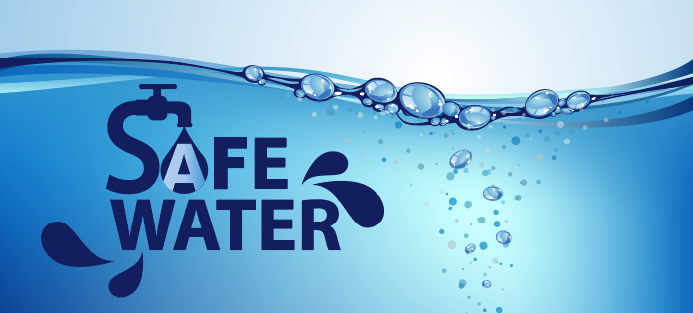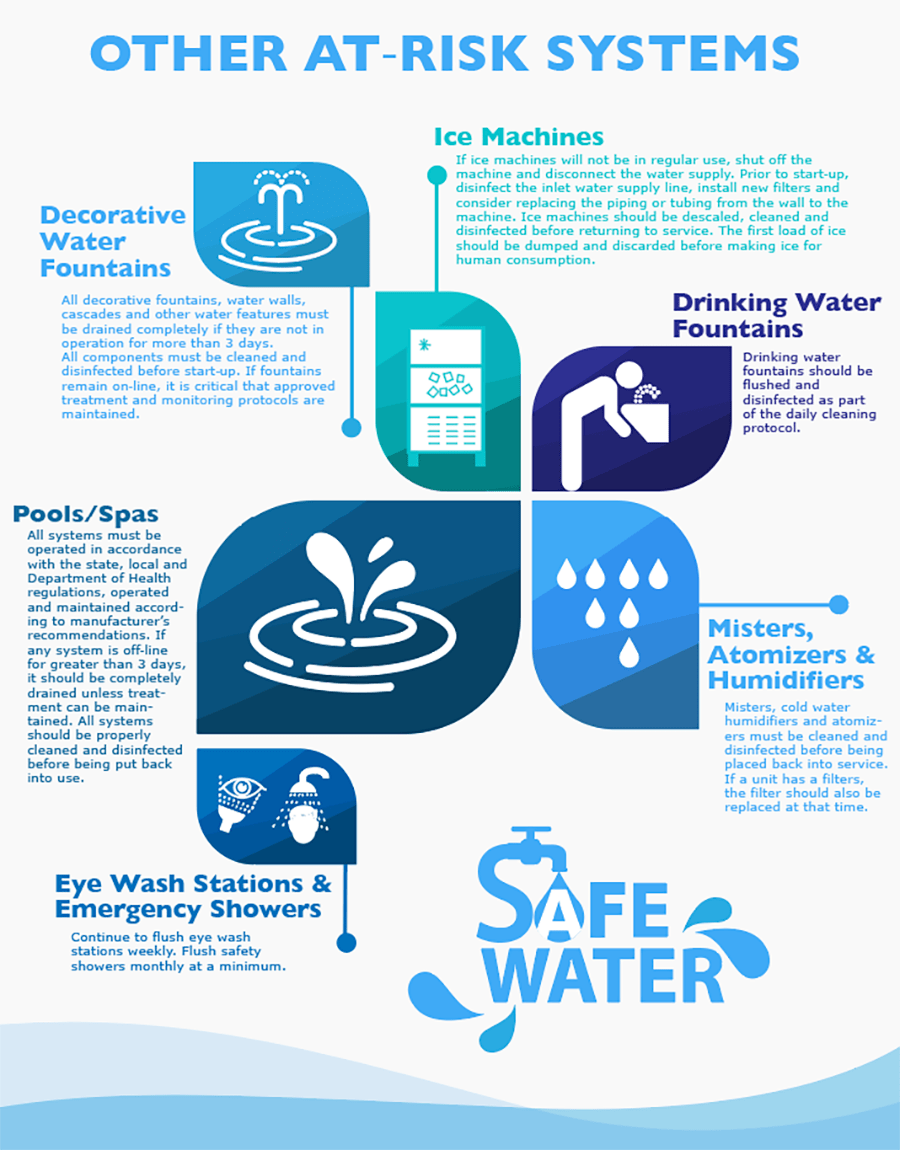Rochester Midland Corporation’s (RMC) number one concern is to ensure the safety of our employees, customers, and those we come into contact with on a daily basis. As a “life‐sustaining business” that provides water treatment chemicals and services along with water safety services, it is our job to keep our customers informed of measures that should be taken to keep people safe as we return to work.
During this time when so many facilities are empty or at reduced capacity, both our domestic water and utility (HVAC and boiler) systems are used less than normal. The reduction in normal operating capacity and normal water flow, results in stagnant water conditions that allow for potentially harmful bacteria such as Legionella, mycobacteria and other water‐borne pathogens to grow in both our domestic and utility water systems. These stagnant water conditions may also promote corrosion, scale formation, and bacteria growth that inhibits heat transfer, resulting in an increase in operating costs. As people come back to work, they will potentially be exposed to the bacteria in the water system if proactive measures are not taken to ensure the safety of those systems. We also need to ensure that the systems that we rely on for heating and cooling will operate effectively and efficiently without any damage to these systems during the slowdown in normal operation.
DOMESTIC WATER SYSTEMS:
The CDC makes specific reference to stagnant water conditions stating that:
“Stagnant or standing water can cause conditions that increase the risk for growth and spread of Legionella and other biofilm‐associated bacteria. When water is stagnant, hot water temperatures can decrease to the Legionella growth range (77 – 108F; 25 – 42 C). Stagnant water can also lead to low or undetectable levels of disinfectant, such as chlorine. Ensure that your water system is safe to use after a prolonged shutdown to minimize the risk of Legionnaires’ disease and other diseases associated with water”.
The CDC, EPA, ASHRAE, AIHA and other organizations have made recommendations for minimizing the risk of bacteria growth in domestic water systems during this pandemic. A few of the recommendations are outlined below with links to each site for more information.
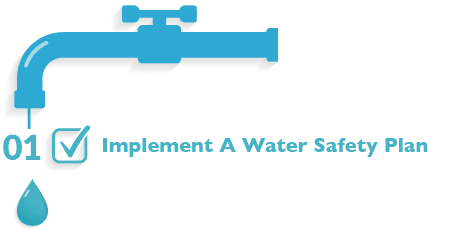
a) Keeping cold water cold ‐ below 77 F. Implement flushing procedures for cold water storage tanks to increase water through‐put. For long‐term shut down – drain, clean and disinfect water storage tanks. Flush and recommission before returning to service.
b) Keeping hot water heater temperatures above 140 F for heating systems with mixing valves, and above 130 F for heating systems without mixing valves (following state laws for scald risk at fixtures). Implement flushing procedures for hot water tanks to increase water throughput. If disinfectant levels remain low, consider adding supplemental chlorine, chloramine or chlorine dioxide. For long‐term shut down – drain, clean and disinfect water storage tanks. Flush and recommission before returning to service.
c) Maintaining water flow. Stagnant water conditions allow for cold water to heat up above recommended ranges, hot water to cool down to temperatures that allow for growth and >allow bacteria – including Legionella to grow.
d) Maintaining chlorine/chloramine/disinfectant levels above 0.3 – 0.5 ppm for hot water fixtures and 0.5 to 1.0 ppm for cold water fixtures (sinks, showers, drinking water fountains, janitors’ sinks, etc.)

a) If there is no water safety plan in place, hot and cold fixtures most distal from the incoming water main should be flushed for 30 minutes once a week until the disinfectant levels reach the recommended ranges outlined above.
b) Once the disinfectant levels have reached recommended levels at the distal fixtures, the remaining fixtures in the building should be flushed for 5 minutes once a week.
c) Legionella testing should be performed at hot and cold fixtures near, mid and distal from the incoming main and each hot water heater at least 3 weeks prior to the building being re‐occupied.
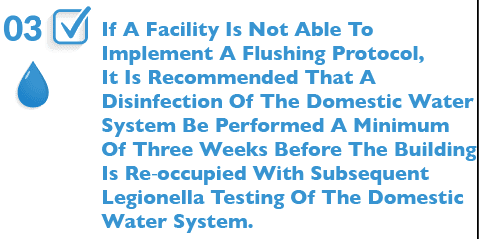
UTILITY WATER SYSTEMS: COOLING TOWER, CLOSED LOOPS, BOILERS:
Numerous organizations make recommendations for protecting systems that are off‐line or that operate intermittently. These organizations include ASME, CTI, AHRAE and the CDC to name a few. Some of the recommendations from these organizations are outlined below.
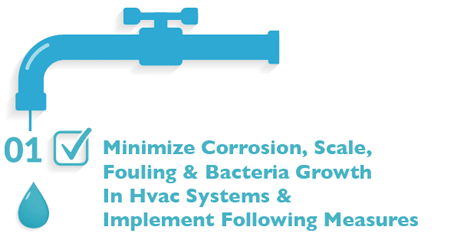
a) Maintain water flow to keep water treated with biocide and corrosion inhibitor so that corrosion is maintained at acceptable levels: Mild steel < 1.0 mpy in condenser water systems and <0.1 mpy in chill loop systems. Copper rates should be less than 0.1 mpy in both cooling tower and chill water systems.
b) Circulate cooling tower loops a minimum of 3 times per week for 4 hours per day while adding biocide and corrosion inhibitor. Some facilities achieve better results from daily circulation of cooling tower systems for 2 – 3 hours. Corrosion inhibitor levels should be maintained at 1.5 times the normal level. Oxidizing biocides should be maintained at 0.5 to 1.0 ppm – 1 hour after biocide feed for 3 days per week and non‐oxidizing biocides should be fed a minimum of once per week at levels recommended by your water treatment company to maintain < 10,000 cfu’s/mil of bacteria via dip slides taken once a week.
c) If a cooling tower system is off‐line for more than 2 weeks without circulation or biocide feed, an on‐line disinfection should be performed before bringing the tower on‐line to minimize the risk of exposure to Legionella bacteria and other water borne pathogens. An on‐line disinfection can be accomplished by adding 50 ppm chlorine to the system as measured by a DR‐900 or other type of colorimeter. The water then needs to be circulated through the entire system (including all condensers, pumps and piping) for a minimum of 4 hours while the bleed system is locked out. The condenser water should then be heavily bled for 24 hours or the tower drained, flushed and refilled with fresh water, corrosion inhibitor and biocide. Alternatively, 10 ppm of chlorine can be circulated for 24 hours followed by a heavy bleed to remove dead bacteria and debris or a flush and refill.
d) Legionella testing of the cooling towers should continue to be performed quarterly and within 3 weeks of the building being re‐occupied. If Legionella counts are more than 100 cfu’s’/mil, an on‐line tower disinfection should be performed with retesting 3 days after flushing the tower. If Legionella counts are > 1,000 cfu’s/mil, the tower should be disinfected, drained, cleaned off‐line, flushed, refilled, disinfected, flushed, refilled and treated. Legionella testing should be performed after the off‐line tower cleaning after 3 days but no later than 7 days after cleaning.
e) Chill water systems should also be circulated a minimum of 3 times per week for 4 hours to prevent corrosion and bacteria growth resulting from stagnant water conditions.

a) Maintain normal operating temperatures with chemical levels within normal ranges. Where boiler systems are not being utilized for more than 7 days at a time and boiler temperatures drop below 180 F, additional sulfite and caustic should be added to the boiler to maintain a minimum pH level of 10‐12, “O” alkalinity levels of 300 – 600 ppm, and a sulfite level of 200 ppm to minimize oxygen pitting in the boiler.
b) Review and implement ASME guidelines for boiler lay‐up and start‐up for off‐line systems.
How can RMC help?
- Implementation of a water treatment plan for your domestic water, HVAC or other utility systems
- Experts to assist you. We can also perform on or off‐line cleaning of your domestic water or cooling tower water systems, provide training for your staff, and/or provide water treatment chemicals, services and consultation.
- If you are concerned about transmission of the COVID‐19 virus from surfaces in your facility, we can provide surface testing for the COVID‐19 virus as well.
- Experts & trained service personnel to help you take measures to keep both your domestic and utility water systems safe for your guests, employees and customers.
The CDC provides guidelines on the development of a water safety plan and guidance on steps to take during the COVID‐19 Here.
Additional information can be obtained at the following websites and or documents:
1. EPA
2. AIHA
3. ASHRAE Standard 188 and ASHRAE Guideline 12‐2000
(a) : Rochester Midland Corporation (RMC) makes no warranties or guarantees with respect to water system biohazards from waterborne pathogens including but not limited to Legionella bacteria. RMC does not and cannot make any guarantee or warranty that the risk of the presence of Legionella or the risk of legionellosis has been reduced or eliminated by reason of these recommendations or any Program provided. RMC accepts no liability for any penalties or fines assessed by the City of New York, the State of New York or any other government or agency.

